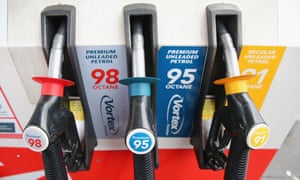The announcement this week by energy minister Angus Taylor that he’s putting together a major package to prop up oil refineries to preserve dirty fuel supplies to one of the dirtiest car fleets on the planet simply beggars belief.
This week, we’ve seen king tides and storms hitting the country’s eastern coastline, changing the face of much-loved Aussie beaches, which were already feeling the effects of rising sea levels. This time last year, the country was on fire. In 2020 our Great Barrier reef was bleached for the third time in five years, the most widespread event ever. We just had the warmest spring ever, 2C above average, which would have been “virtually impossible” without our greenhouse gas emissions.
We are facing an increased onslaught of climate impacts that will just accelerate unchecked without global action on climate to rapidly reduce emissions: a recent report showed Australia was the G20’s fourth highest most vulnerable to climate risk.
The transport sector is the third largest source of emissions in the Australian economy, after electricity and industry. In 2019, transport represented 18% of total emissions, an increase of 22% since 2005. According to Taylor’s own projections these are set to grow by 6% between 2020 and 2030, when they would be close to 21% of national emissions. Road transport accounts for the 85% of those emissions, and car emissions have grown 25% since 1990.
Australia is one of the few countries in the world with no emissions nor fuel efficiency standards for light duty vehicles. The government has given no indication of any intention of introducing them, despite five years of deliberations in the ministerial forum on vehicle emissions.
And it gets worse. Australia’s fuel quality is amongst the worst in the OECD with high sulphur content at levels banned in the EU ten years ago. Last year the government allowed this to continue to 2027. One consequence, apart from health effects, is that many very efficient internal combustion engine vehicles that can only run on low sulphur premium unleaded will not be sold in Australia.
It seems the government is poised to release a federal strategy around electric vehicles (EVs). A draft discussion document, which was leaked on Tuesday, contains no emissions standards, nor targets for EVs (nor any other new support for them), except an already-announced co-funding arrangement for charging stations. And a two year electric car trial for the cars that ferry the likes of Taylor around. Why a trial is needed for EVs in 2020 is incomprehensible. And why an EV strategy should morph into a “future fuels strategy” is very hard to explain.
The $72m for charging station co-funding clearly isn’t enough, because various states are planning road user charges on EVs to pay for them, a move likely to discourage and slow their uptake, at the very time the opposite is needed.
The resources seemingly earmarked in the leaked draft discussion document appear dwarfed by the planned $2.3bn subsidy to oil refineries.
Taylor seems to be wilfully ignoring Australia’s huge transport emissions problem.
The Australian fleet of 19.2 million vehicles is one of the world’s most polluting and least efficient, far behind the US, China, Japan, India and the European Union. Their projected improvement means Australia will fall even further behind. Nearly 80% of new light-duty vehicles sold globally are subject to some kind of emissions or fuel economy standard.
The International Energy Efficiency 2018 Scorecard for transportation rated Australia 20th out of 26 countries, with only countries like Turkey and Saudi Arabia rating worse. In the absence of any such standards for vehicles in Australia, along with modern pollution standards, it’s increasingly likely that Australia will become the dumping ground for cars that cannot be sold in other markets.
This is a disgraceful track record of inaction and regressive outcomes, one that the minister should not be at all proud of, that effectively meets and beats the lowest motor vehicle and fuel standards in the OECD, if not the planet.
It doesn’t have to be like this.
The Climate Action Tracker has modelled a Paris agreement-aligned benchmark for Australian transport, which would require Australia to increase its share of electric (or emissions-free) vehicles in new vehicle sales from less than 1% today for personal cars to 95% in 2030, reaching 100% in 2035. This would translate into roughly 38% EV share in the total fleet in 2030 and a full decarbonisation of this fleet by mid-century.
But to achieve this, Australia needs stringent new standards for the CO2 emissions intensity of new vehicles, a target for EVs, incentives to support their uptake - and of course strategies to increase the share of public transport.
EVs would require more electricity, and also when integrated with a modern grid providing important grid services. Tapping into the vast renewables resources available in Australia and getting the country onto a 1.5C Paris agreement compatible pathway would not only provide the renewable energy for an EV network, it would also provide literally tens of thousands of jobs for Australians, far more than the ones Taylor is seeking to protect with his fuel package.

No comments:
Post a Comment